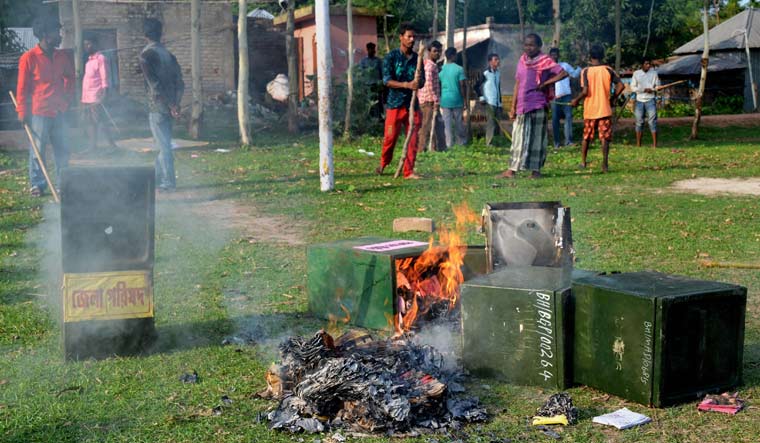Prime Minister Narendra Modi raising alarm about political violence in West Bengal has made it clear that the BJP’s next big target would be West Bengal.
Modi, while addressing BJP workers in Delhi after party's good show in Karnataka elections, reminded people of two tragic incidents. One was the killing of people in a fly-over crash in his constituency Varanasi on Tuesday and the other was the killing of people in political violence in West Bengal during Panchyat elections.
The prime minister has asked all the political parties, civic society and even judiciary to look into the “dangerous” political environment of West Bengal which “decades back had showed path to the rest of India”.
“Is this the Bengal that we knew for decades?” he asked.
At least 23 people have lost their lives so far in violence related to panchayat elections. After Modi’s outburst, West Bengal BJP made it clear that the party would be ready to sacrifice lives to bring back the glory of Bengal.
“Our head hanged in shame when the prime minister uttered such words. Only the BJP could bring out the state out of such a crisis. Nobody else would be able to do that,” said BJP state president Dilip Ghosh, pointing to the “complete fall of law and order situation” in the state.
But why is Bengal prone to such political violences? While more than 50,000 booths in Karnataka went to poll without any violence reported, a local level election in Bengal witnessed a huge bloodbath. Re-polling will be held in almost 600 booths on Wednesday and chances are high that the violence would rock the state again. More than 3000 people, injured in the violence, have been hospitalised across the state.
In Bengal, where the panchyat systems started functioning, it has been decentralised much more, thanks to the left front government. In most of the states, only zilla parishads are being elected politically and local sarpanch or panchyats are full with elected representatives who are apolitical. In West Bengal, however, after zilla parishad, it goes down to panchyat samity and gram panchyat which have politically elected representatives. What is much more interesting is that there is considerable amount of financial power vested upon the gram panchyats which have only 15 to 21 people maximum.
Many of them have not got proper training in administration.
Said an IAS officer in Bengal, “Each of the panchyat has the power of granting projects worth Rs 3 to Rs 5 crore. The money is deposited into the panchyat’s account and they can sign in the cheques as well.”
Earlier Block Development Officers had power to control the spending seeing the progress of the project, the officer said.
“But now, even administrative officials, who are evaluated by their superiors, cannot have any say on this. The power has been taken away slowly but steadily in the name of decentralisation,” said the officer, who is now posted outside West Bengal.
Lack of jobs in rural Bengal has made posts like panhyat pradhan most lucrative in Bengal. There are around 46,000 panchyats each of which elect a body of around 20 members. The ruling groups have all the power to spend crores of rupees per year.
That has led to clash over dominance as ruling party would like to have their own men in order to check the growing dissatisfaction in its ranks. Also, rampant poverty and unemployment in rural backyards made government adapt such a rule in which considerable number of people earn money in the name of “self governance” resulting in massive misuse of government resources.
On the top of it, there is an administration which lacks impartiality. The annual confidential report (ACR) of the senior administrative officers is done by the chief minister instead of chief secretary. In most of the states, some powers are vested on the governor which is the appointing authorities of civil servants like IAS and IPS. So, the administrative cadres in Bengal are most likely be prone to work under pressure and very loyal to their bosses, whether left government or Mamata Banerjee government.
The situation has gone to such a pass that the state could not get an election commission which could act independently. The responsibility of panchyat election lies as much with government of West Bengal as on state election commission.
The line between executives and governments have been blurred and they are reciprocal to each other in terms of extending their helping hands while doing good or even bad.
Modi’s plea to judiciary to look into the situation in Bengal is much more meaningful and thoughtful. But he would have to initiate the process, and cannot rely on the government of West Bengal, which has even refused to acknowledge the deaths in violence.
Will he be able to do that? Only time will prove.


